Public education has long been a cornerstone of societal progress. It serves as a powerful tool to equip individuals with the skills needed to thrive in an ever-changing world. By fostering critical thinking and creativity, it lays the foundation for a brighter future.
Historically, public education has played a pivotal role in driving economic growth and cultural development. From the industrial revolution to the digital age, it has adapted to meet the needs of each generation. This adaptability ensures its continued relevance in shaping tomorrow’s leaders.
Accessibility remains a key factor in its success. By providing equal opportunities, public education empowers individuals from all walks of life. This inclusivity not only benefits individuals but also strengthens communities as a whole.
Key Takeaways
- Public education transforms societies by equipping individuals with essential skills.
- It drives economic growth and cultural development.
- Accessibility ensures equal opportunities for all.
- Historical milestones have shaped modern educational practices.
- It fosters critical thinking and creativity for a brighter future.
Overview of Public Education in the Philippines
Access to quality education remains a priority in the Philippines. The country has worked to expand its school system, ensuring that more students can benefit from learning opportunities. With a focus on inclusivity, the government aims to bridge gaps between urban and rural areas.
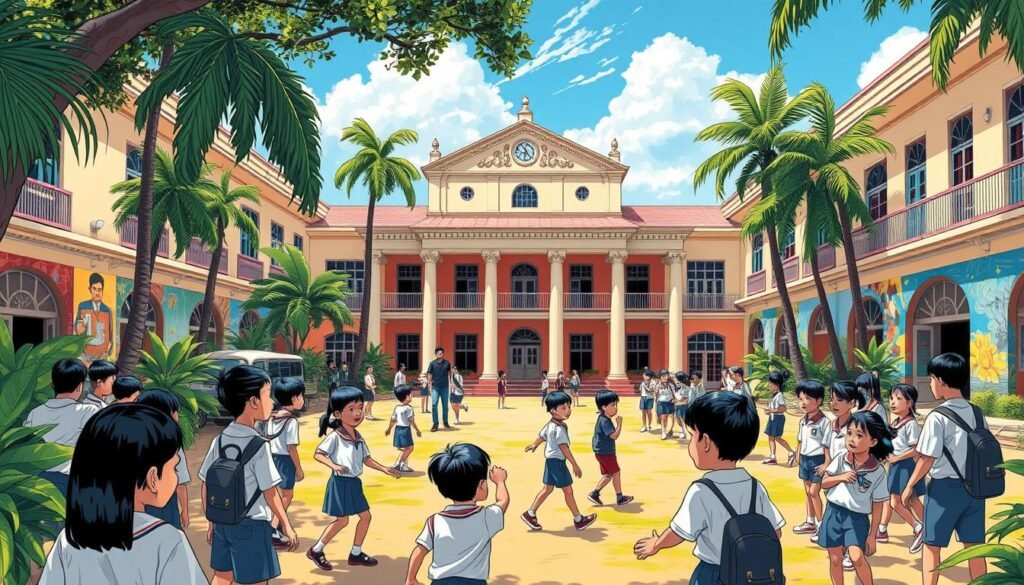
The Philippine school system is structured into basic, tertiary, and technical-vocational levels. The K to 12 Program, implemented in 2012, extended basic education to 13 years. This reform includes kindergarten, six years of elementary, four years of junior high, and two years of senior high school.
Equitable access to education is a cornerstone of the system. Programs like the Alternative Learning System (ALS) provide opportunities for students in remote areas. Despite these efforts, challenges like overcrowded classrooms and resource shortages persist.
According to the Sustainable Development Goals Report, the Philippines has made progress in enrollment rates. However, disparities remain, particularly in regions like Mindanao. The government continues to invest in infrastructure and teacher training to address these issues.
Compared to global benchmarks, the country’s education system is evolving. While literacy rates are high, there is room for improvement in student performance and resource allocation. The focus remains on creating a system that meets the needs of all learners.
Historical Evolution of Public Education
From ancient oral traditions to modern classrooms, the way we learn has transformed. The journey of learning reflects the development of human society, adapting to meet the needs of each era. Understanding this evolution helps us appreciate the systems we have today.
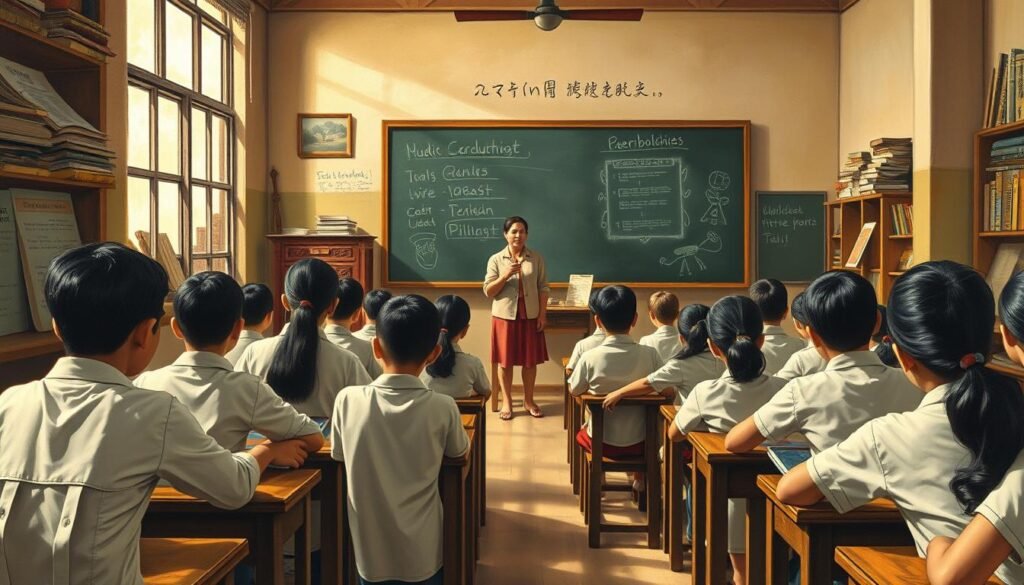
From Prehistoric Learning to Ancient Institutions
In prehistoric times, learning was informal. Knowledge was passed down orally through stories and practical demonstrations. This method ensured survival skills and cultural traditions were preserved.
As society grew more complex, formal institutions emerged. Ancient Egypt and China established some of the earliest schools. These institutions focused on training scribes, priests, and leaders, marking a shift toward structured learning.
The invention of writing revolutionized access to knowledge. It allowed information to be recorded and shared across generations. This milestone laid the foundation for modern educational practices.
Transition to Modern Education
The printing press in the 15th century further democratized learning. Books became more accessible, spreading knowledge beyond elite circles. This innovation played a key role in the development of public education systems.
By the 19th century, many countries began adopting compulsory schooling. Prussia, for example, introduced mass education to create a disciplined workforce. This marked a shift from elitist systems to more inclusive models.
Today, modern education caters to a broader segment of society. It emphasizes critical thinking, creativity, and inclusivity. Historical milestones have shaped the frameworks we rely on to equip future generations.
| Era | Key Development | Impact on Society |
|---|---|---|
| Prehistoric | Oral transmission of knowledge | Preserved survival skills and culture |
| Ancient | Establishment of formal schools | Training for scribes and leaders |
| 15th Century | Invention of the printing press | Democratized access to knowledge |
| 19th Century | Compulsory schooling in Prussia | Shift toward inclusive education |
Emergence of Public Education as a National Priority
The rise of public education as a national priority reflects its critical role in societal advancement. Governments worldwide have recognized its transformative potential, embedding it into their policy agendas. This shift underscores the belief that access to learning is a fundamental right for all.
Legislative and constitutional mandates have played a key role in this evolution. For example, the Philippines’ 1987 Constitution guarantees the right to quality education. Similarly, global frameworks like the UN’s Sustainable Development Goals emphasize universal access to learning. These mandates have united nations in their commitment to advancing public education.
Government initiatives have further solidified this priority. In the Philippines, the K to 12 Program extended basic education to 13 years, aligning with global standards. International organizations like the World Bank have also supported these efforts, investing billions to bridge financing gaps. Such initiatives highlight the collective responsibility required to uphold education as a national right.
Comparing the Philippines with global trends reveals both progress and challenges. While enrollment rates have improved, disparities persist, particularly in rural areas. Addressing these gaps requires united efforts from governments, communities, and international partners. This collaboration ensures that education remains a cornerstone of national development.
Public education’s emergence as a priority reflects its power to transform societies. By embedding it into national policy, governments can create a brighter future for all. This journey highlights the importance of collective action and shared responsibility in advancing learning opportunities.
Defining Education and Its Multifaceted Dimensions
Understanding the multifaceted dimensions of learning is essential to grasp its true impact. It is a dynamic process influenced by cultural, social, and individual factors. This section explores its various forms, philosophies, and real-world applications.
Key Definitions and Concepts
Academic perspectives define learning as the acquisition of knowledge, skills, and values. It is not limited to classrooms but extends to everyday experiences. As Jackson (2011) notes, “Learning is shaped by historical and cultural contexts, making it a deeply contextualized process.”
This term also encompasses the development of critical thinking and problem-solving abilities. These skills are crucial for adapting to an ever-changing world. Understanding these definitions provides a foundation for exploring its broader dimensions.
Formal vs. Non-Formal Learning Approaches
Formal learning occurs in structured environments like schools and universities. It follows a curriculum and is often teacher-centered. Non-formal learning, on the other hand, takes place in community centers or workshops, offering flexibility and practical insight.
Informal learning happens through daily experiences, such as observing others or self-directed exploration. Each approach has unique strengths, catering to different needs and contexts. For example, non-formal programs in the Philippines have helped bridge gaps in rural areas.
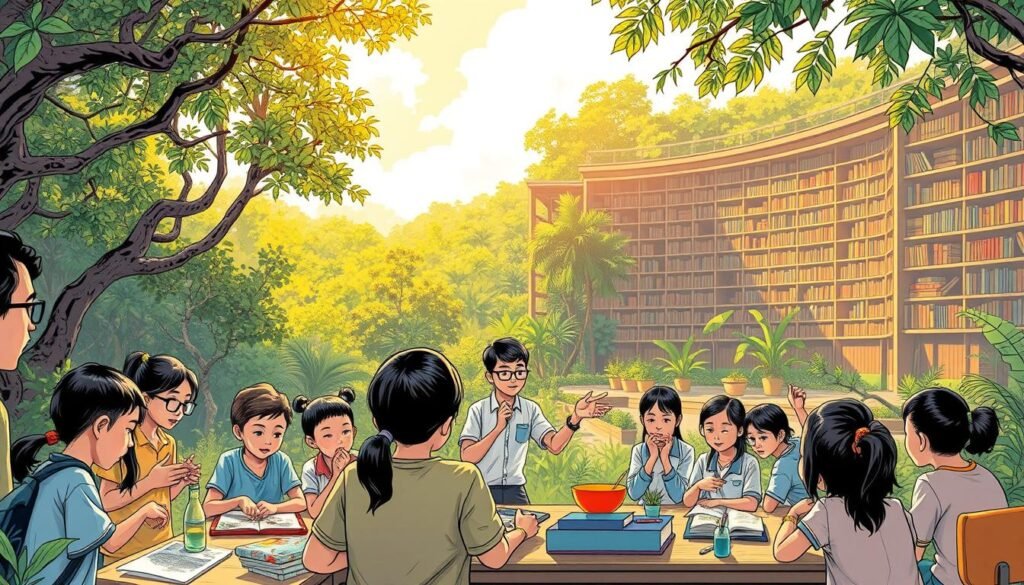
Educational philosophies further shape these approaches. Teacher-centered models focus on direct instruction, while student-centered methods emphasize active participation. Both play vital roles in creating effective learning experiences.
| Approach | Environment | Key Characteristics |
|---|---|---|
| Formal | Schools, Universities | Structured, Curriculum-Based |
| Non-Formal | Workshops, Community Centers | Flexible, Practical |
| Informal | Daily Life, Self-Directed | Experiential, Unstructured |
Real-life examples illustrate these dimensions. For instance, early intervention programs in the Philippines have improved primary school performance. Such initiatives highlight the importance of context-dependent definitions in achieving effective outcomes.
By understanding these diverse approaches, we can better appreciate the transformative power of learning. It is not just a process but a lifelong journey that shapes individuals and societies.
Social Impact of Public Education on Community and Culture
Communities thrive when learning opportunities are equitable and inclusive. Public learning systems play a vital role in fostering economic growth and cultural preservation. By empowering individuals, they create a ripple effect that strengthens entire communities.
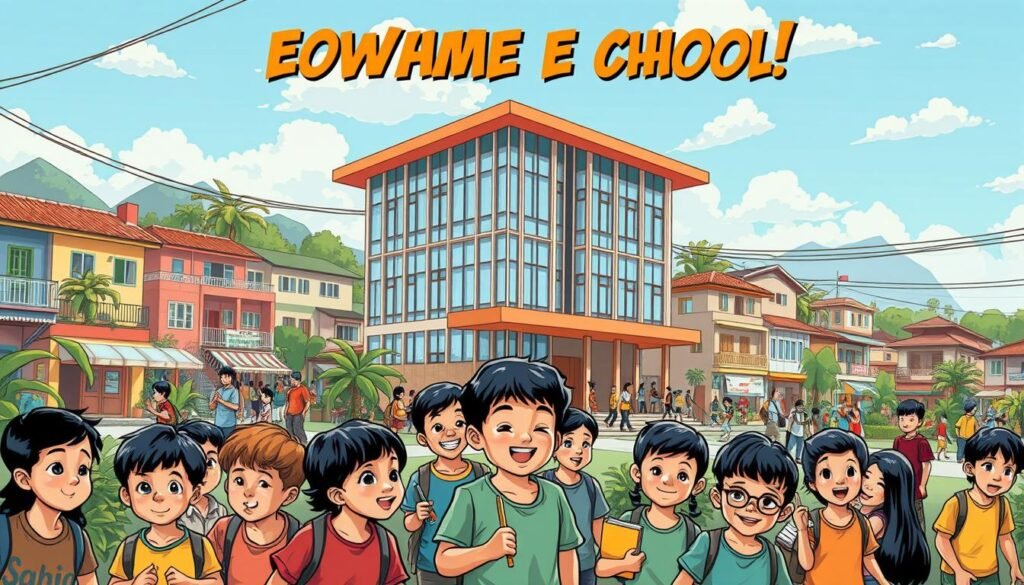
Economic and Cultural Benefits
Public learning systems are a driving force behind economic development. According to the World Bank, countries investing in learning see a direct correlation with GDP growth. For example, the Philippines’ K to 12 Program has improved workforce readiness, creating more job opportunities.
Culturally, these systems help preserve traditions while fostering progress. Culturally relevant curricula ensure that local values are integrated into learning. This approach not only strengthens cultural identity but also promotes social cohesion.
Success stories from around the world highlight the transformative power of learning. In rural areas of the Philippines, programs like the Alternative Learning System (ALS) have empowered marginalized communities. These initiatives have raised living standards and created new opportunities for growth.
Equality is another key benefit. By providing access to learning, public systems bridge gaps between urban and rural areas. This ensures that everyone, regardless of background, has the chance to succeed. Such inclusivity strengthens communities and promotes social harmony.
Public learning systems also play a crucial role in shaping future leaders. By equipping individuals with critical thinking and problem-solving skills, they prepare them to tackle global challenges. This, in turn, drives innovation and economic progress.
In summary, the social impact of public learning systems is profound. They create opportunities, promote equality, and preserve cultural values. By investing in these systems, communities can build a brighter, more inclusive future.
Public Education as a Human Right
Access to learning is not a privilege but a fundamental human right. It empowers individuals, fosters equality, and drives societal progress. Denying this right limits a child’s potential and perpetuates cycles of poverty.
International conventions, such as the Universal Declaration of Human Rights and the Convention on the Rights of the Child, affirm this right. These agreements emphasize that every child deserves quality learning opportunities, regardless of their background.
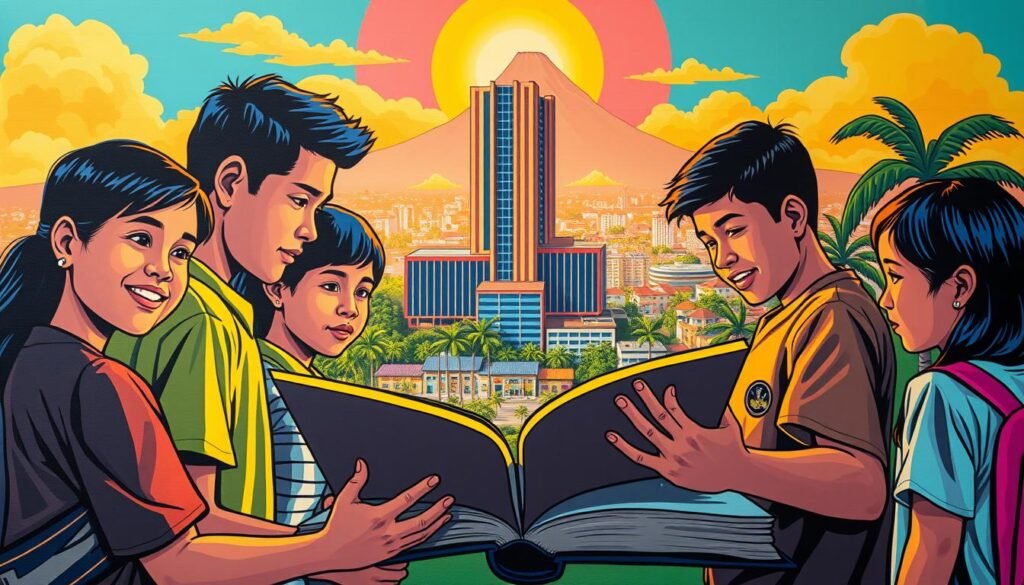
Gender disparities remain a significant barrier. Globally, millions of girls are denied access to learning due to cultural norms, poverty, or conflict. Initiatives like Malala Fund and UNICEF work tirelessly to ensure girls can attend school and thrive.
In the Philippines, programs like the Alternative Learning System (ALS) provide opportunities for marginalized children. These efforts highlight the importance of inclusive policies to bridge gaps in access.
Addressing inequities is urgent. According to UNESCO, over 260 million children and youth are out of school worldwide. Ensuring every child can learn is essential for building a brighter, more equitable future.
By upholding the human right to learning, we empower individuals and strengthen communities. It’s a collective responsibility to ensure no child is left behind.
The Role of Teachers in Fostering Learning
Teachers are the backbone of any successful learning system, shaping the minds of future generations. Their influence extends beyond academics, impacting students’ social, emotional, and personal development. Skilled teachers not only impart knowledge but also inspire curiosity and critical thinking in their students.
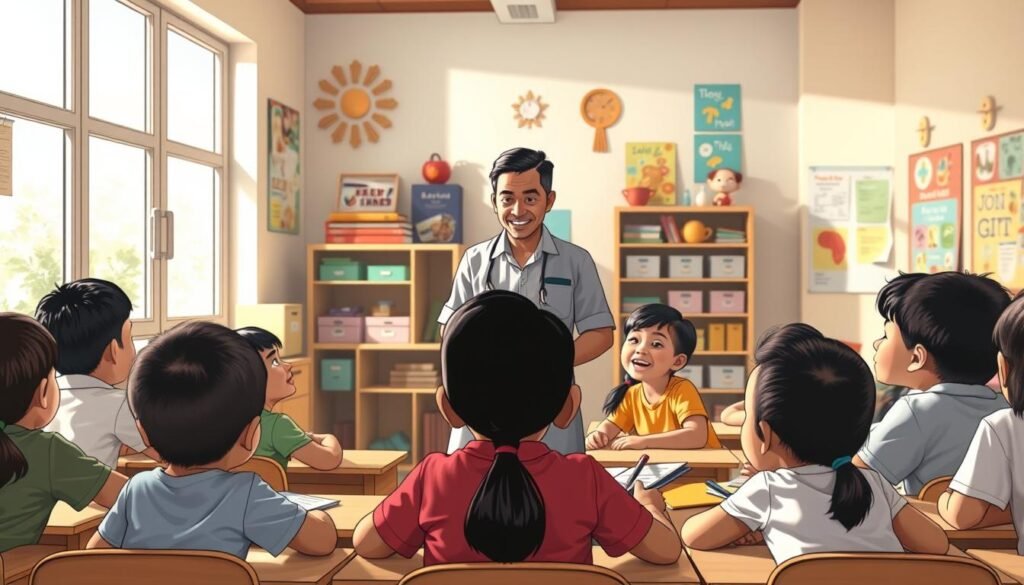
Research shows that positive teacher-student relationships can boost engagement and academic performance by 20%. Teachers also play a crucial role in mentoring, with 75% of educators believing their responsibilities include guiding students through life challenges. This holistic approach ensures students are well-prepared for future success.
Teacher-Centered Approaches
In teacher-centered methods, the instructor leads the learning process. This approach emphasizes direct instruction, structured lessons, and clear objectives. It is particularly effective for foundational subjects where consistency and discipline are key.
For example, in the Philippines, teacher-centered methods have been instrumental in improving literacy rates. However, this approach can sometimes limit creativity and independent thinking. Balancing structure with flexibility is essential for fostering well-rounded students.
Student-Centered Methods
Student-centered learning shifts the focus to the individual needs and interests of students. This method encourages active participation, collaboration, and problem-solving. It helps students develop critical skills like communication, teamwork, and adaptability.
Innovative programs in countries like Finland have shown the effectiveness of student-centered approaches. These methods not only improve academic outcomes but also enhance emotional well-being and motivation. Teachers act as facilitators, guiding students through self-directed learning journeys.
| Approach | Key Features | Impact on Students |
|---|---|---|
| Teacher-Centered | Structured, Direct Instruction | Builds foundational knowledge |
| Student-Centered | Collaborative, Self-Directed | Develops critical thinking and creativity |
Professional development is vital for teachers to adapt to these evolving methods. Continuous training enhances teaching effectiveness by 15-20%, ensuring educators stay updated with the latest pedagogical techniques. Investing in teachers ultimately benefits students, creating a more dynamic and inclusive learning environment.
From the Philippines to Finland, innovative teaching practices have transformed learning outcomes. By embracing both teacher-centered and student-centered methods, educators can equip students with the skills needed to thrive in an ever-changing world.
Policy and Strategy for Quality Education
Effective policies are the backbone of quality learning systems worldwide. Governments and organizations are working tirelessly to ensure that every student has access to the resources they need to succeed. This section explores the initiatives, standards, and research driving these efforts.
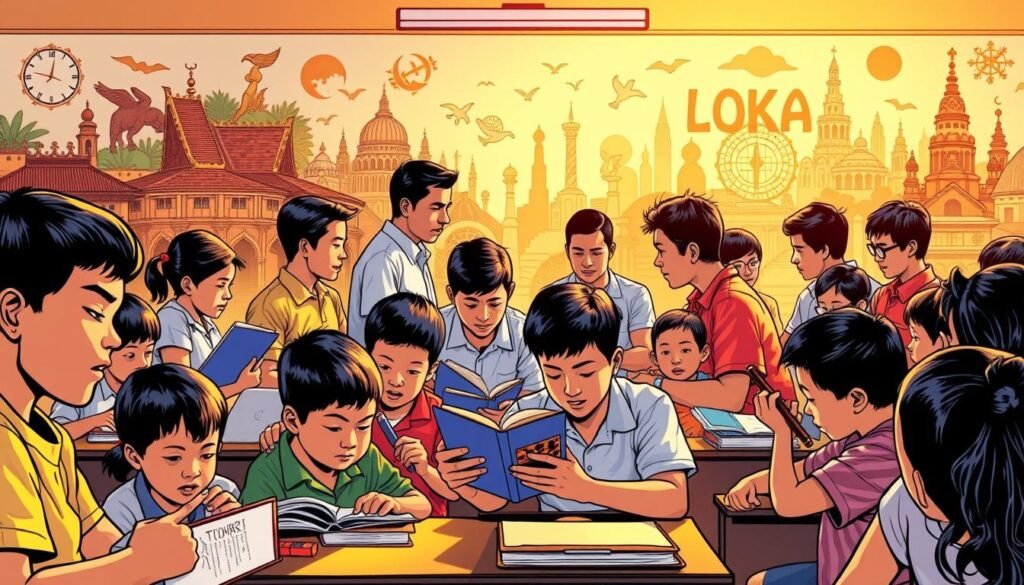
Government Initiatives and International Standards
In the Philippines, the K to 12 Program stands as a testament to the government’s commitment to improving learning quality. This reform aligns with international benchmarks, ensuring students are competitive on a global scale. Programs like the Alternative Learning System (ALS) further bridge gaps for marginalized communities.
Globally, frameworks like the UN’s Sustainable Development Goals (SDGs) provide a roadmap for achieving equitable access. Countries like Finland and South Korea have set high standards, emphasizing teacher training and student-centered approaches. These models offer valuable lessons for the Philippines and other nations striving for excellence.
Research Findings and Evidence-Based Policy
Research plays a crucial role in shaping effective policies. Studies show that investing in teacher training and infrastructure can boost student performance by up to 20%. Evidence-based approaches ensure that reforms are grounded in data, leading to sustainable improvements.
For example, the World Bank highlights the importance of addressing gender disparities in learning. Initiatives targeting girls’ access to schools have shown significant success in countries like Bangladesh. These findings underscore the need for inclusive policies that leave no one behind.
Comparing Global Policies for Actionable Insights
Comparing policies across countries reveals both successes and challenges. Finland’s focus on teacher autonomy and student well-being has led to consistently high performance. In contrast, overcrowded classrooms and resource shortages remain issues in the Philippines.
By learning from global best practices, the Philippines can adapt proven strategies to its unique context. This includes prioritizing teacher development, expanding access to technology, and fostering community involvement.
Future Directions for Sustaining Quality Learning
Looking ahead, sustaining quality learning requires continuous innovation and collaboration. Policymakers must prioritize funding, teacher training, and research to address emerging challenges. Embracing international partnerships can also amplify these efforts, ensuring that every student has the opportunity to thrive.
By focusing on evidence-based strategies and global benchmarks, the Philippines can build a brighter future for its learners. This journey highlights the importance of collective action and shared responsibility in advancing quality learning systems.
Advancements in Educational Research and Global Trends
The field of learning is undergoing rapid transformation, driven by groundbreaking research and global trends. These advancements are reshaping how we teach and learn, creating a more dynamic and inclusive environment for students worldwide.
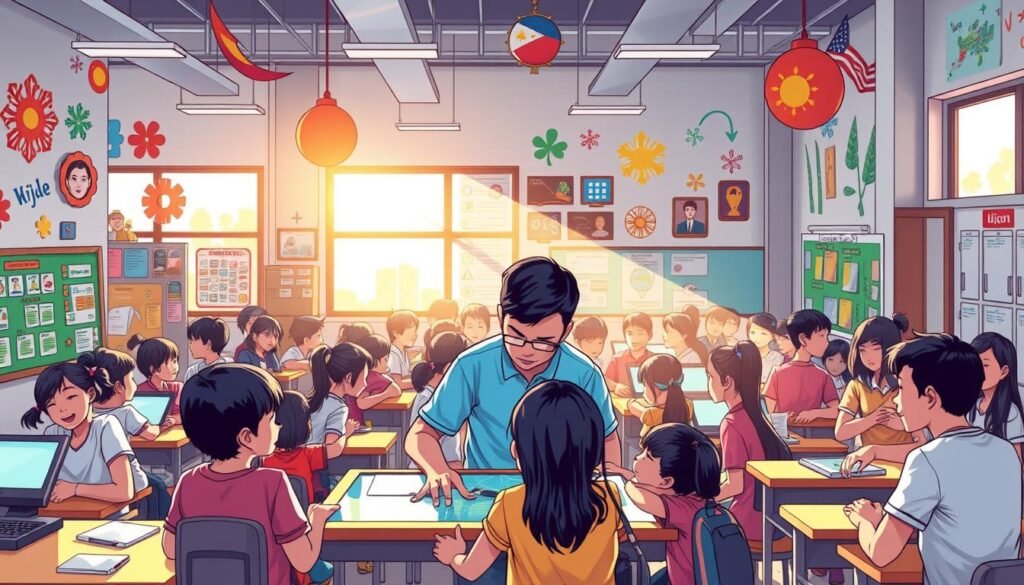
Recent breakthroughs in teaching methods have emphasized the importance of intelligence and adaptability. For example, collaborative learning has been shown to improve retention and foster critical thinking. This approach encourages students to work together, enhancing their problem-solving skills and new perspectives.
Technological innovations are also playing a pivotal role in shaping the global learning environment. The rise of online and hybrid models has expanded access to resources, particularly in remote areas. In the Philippines, programs like the Alternative Learning System (ALS) have embraced these tools to reach underserved communities.
Emerging trends such as personalized learning and gamification are redefining classroom practices. Personalized learning tailors instruction to individual needs, while gamification makes learning more engaging. These new methods are helping students develop essential skills for the future.
- Collaborative learning boosts retention and critical thinking.
- Technology expands access to resources in remote areas.
- Personalized learning adapts to individual student needs.
- Gamification enhances engagement and motivation.
Evidence-based research has led to significant improvements worldwide. For instance, studies show that teacher training and infrastructure investments can boost student performance by up to 20%. These findings highlight the importance of data-driven strategies in achieving quality learning.
Comparing international trends with local developments reveals both progress and challenges. While countries like Finland prioritize teacher autonomy, the Philippines continues to address issues like overcrowded classrooms. Adapting global best practices to local contexts is essential for sustainable growth.
Looking ahead, these advancements have profound implications for future strategies. Policymakers must focus on funding, teacher development, and technological integration to ensure equitable access. By embracing new innovations, we can create a brighter future for learners everywhere.
For more insights on how these trends are shaping the future of learning, explore this detailed analysis.
Expanding Access to Quality Education in the Philippines
Ensuring equal access to learning opportunities remains a critical challenge in the Philippines. The country’s diverse geography and economic disparities create significant gaps between urban and rural areas. Addressing these issues is essential for achieving equitable quality learning outcomes nationwide.
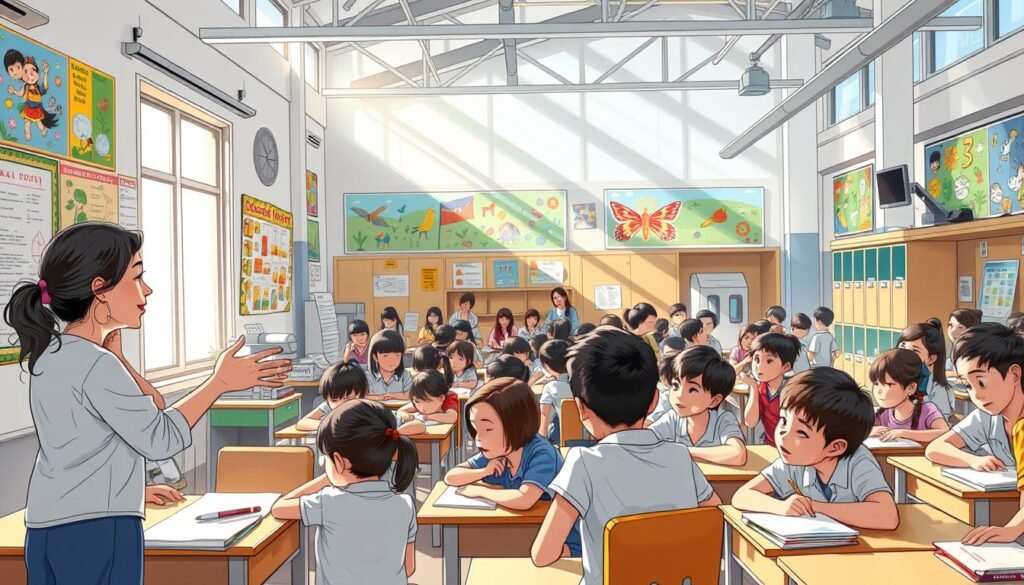
Bridging Rural and Urban Disparities
Rural areas often face severe resource shortages, including overcrowded classrooms and a lack of qualified teachers. Poverty exacerbates these challenges, with many families unable to afford basic school supplies or transportation. According to the Department of Education, only 27% of students in rural areas have internet access, compared to 47% in urban regions.
Government initiatives like the K to 12 Program and the Alternative Learning System (ALS) aim to bridge these gaps. The ALS, for example, has reached over 900,000 learners, improving literacy rates in underserved communities. These efforts highlight the importance of targeted interventions in achieving equitable quality learning.
Impact of Poverty on Access
Poverty remains a significant barrier to learning in the Philippines. Data shows that only 17% of children from the poorest households attend higher education, compared to 49% from wealthier families. Programs like the Pantawid Pamilyang Pilipino Program (4Ps) have been effective in increasing enrollment and reducing dropout rates among low-income families.
Community-driven initiatives also play a vital role. Organizations like Childhope Philippines provide mobile education units and psychosocial support to street children. These efforts demonstrate the power of local action in addressing systemic challenges.
Improving Learning Outcomes
Targeted interventions have shown promising results in improving outcomes. For instance, UNICEF’s temporary learning spaces have benefited over 18,000 learners in conflict-affected areas. Similarly, the Global Partnership for Education’s $20.9 million grant has supported infrastructure improvements and teacher training.
Despite these successes, challenges persist. Over 5,000 schools lack access to electricity, and 10,000 schools do not have potable water. Addressing these issues requires sustained investment and innovative solutions.
Replicating Successful Models
Successful models, such as the ALS and 4Ps programs, offer valuable lessons for other regions. These initiatives emphasize community involvement, tailored approaches, and data-driven strategies. By replicating these models, the Philippines can continue to expand access to quality learning.
As the country moves forward, collaboration between government, NGOs, and local communities will be crucial. Together, these efforts can create a brighter future for all learners, ensuring that no child is left behind.
Embracing Digital Transformation in Education
Digital transformation is reshaping classrooms, making learning more interactive and accessible. By integrating technology, schools are modernizing traditional methods and creating dynamic environments for students. This shift is not just about tools but about transforming how we teach and learn.
Integrating Technology for Interactive Learning
Digital tools like interactive video content and online resources are revolutionizing learning experiences. These tools make lessons more engaging and personalized, catering to diverse learning styles. For example, schools in the Philippines are using platforms like DepEd Commons to provide free access to educational materials.
According to a UNESCO report, “Technology can bridge gaps in access and quality, especially in underserved areas.” This statement highlights the transformative potential of digital tools in creating equitable learning opportunities.
Government and private sector partnerships are driving this change. Initiatives like the K to 12 Program have incorporated ICT training for teachers, ensuring they can effectively use technology in classrooms. Private companies are also contributing by providing devices and internet access to schools in remote areas.
- Interactive video content enhances engagement and retention.
- Online resources provide access to up-to-date information.
- Partnerships between governments and private sectors amplify impact.
Successful examples include schools in Metro Manila that have adopted blended learning models. These schools combine face-to-face instruction with online activities, improving student performance and participation. Such models demonstrate the benefits of integrating technology into traditional classrooms.
Challenges and Benefits of Digital Transformation
While the benefits are clear, challenges like infrastructure gaps and teacher training remain. Overcrowded classrooms and limited internet access in rural areas hinder progress. However, targeted action can address these issues, ensuring no student is left behind.
| Challenge | Solution |
|---|---|
| Infrastructure gaps | Invest in internet connectivity and devices |
| Teacher training | Provide ICT training and professional development |
| Resource limitations | Leverage partnerships for funding and support |
For more insights on how digital transformation is shaping the future of learning, explore this detailed analysis.
By embracing digital transformation, schools can create more inclusive and effective learning environments. This shift not only enhances student outcomes but also prepares them for a technology-driven future.
Addressing Challenges in Achieving Quality Education
Achieving quality learning outcomes in the Philippines requires overcoming significant financial and infrastructural barriers. These challenges hinder progress and limit opportunities for millions of students. Addressing them is essential for building a brighter future.
Financial Constraints
Budget limitations remain a major obstacle. According to a UN report, the Philippines allocates only 3.6% of its GDP to education, far below the recommended 6%. This shortfall affects teacher salaries, classroom resources, and student support programs.
Families also face financial burdens. Many cannot afford school supplies or transportation, leading to higher dropout rates. In rural areas, poverty forces children to work instead of attending school.
Infrastructural Gaps
Overcrowded classrooms and outdated facilities are common issues. A recent study found that 40% of schools lack adequate classrooms, forcing students to learn in makeshift spaces. This environment hampers effective teaching and learning.
Access to technology is another challenge. Only 27% of rural students have internet access, compared to 47% in urban areas. This digital divide limits opportunities for remote learning and skill development.
“Without adequate funding and infrastructure, achieving quality education remains a distant goal.” – UN Sustainable Development Report
Impact on Teachers and Students
Budget constraints directly affect teacher effectiveness. Low salaries and limited training opportunities reduce morale and retention rates. As a result, many schools struggle to maintain qualified staff.
Students also suffer. Research shows that resource shortages lead to lower academic performance and higher dropout rates. Addressing these issues is critical for improving outcomes.
Case Studies and Solutions
Programs like the Alternative Learning System (ALS) have shown promise. By providing flexible learning options, ALS has reached over 900,000 marginalized learners. However, scaling such initiatives requires sustained investment.
Government and NGO partnerships are essential. For example, the Global Partnership for Education has funded infrastructure improvements and teacher training in the Philippines. These efforts highlight the importance of collaboration.
- Increase education funding to meet international benchmarks.
- Invest in infrastructure to reduce overcrowding and improve facilities.
- Expand access to technology for remote and underserved areas.
- Provide financial support to low-income families to reduce dropout rates.
To work towards these goals, stakeholders must prioritize education in their year-round agendas. By addressing financial and infrastructural barriers, the Philippines can create a more equitable and effective learning system.
For more insights on how to address the challenges in education, explore this detailed analysis.
The Role of Public Education in Community Development
Empowering communities through learning fosters sustainable development. Public learning systems are key drivers of economic growth, social cohesion, and cultural preservation. By equipping individuals with essential skills, they create a ripple effect that strengthens entire communities.
One of the most significant impacts is on economic development. Studies show that communities with higher literacy rates experience increased business activity and property values. For example, in the Philippines, programs like the Alternative Learning System (ALS) have empowered marginalized groups, creating new opportunities for growth.
Learning also plays a crucial role in addressing gender disparities. Globally, millions of girls are denied access to learning due to cultural norms or poverty. Initiatives like Malala Fund and UNICEF work to ensure girls can attend school and thrive. In the Philippines, programs targeting gender equality have improved enrollment rates and reduced dropout rates among girls.
Community participation is another key factor. When local groups are involved in learning initiatives, the results are more sustainable. For instance, the ALS program in rural areas has seen success by engaging parents and community leaders. This collaborative approach ensures that learning solutions are tailored to local needs.
“When families and communities are involved, students learn more effectively.” – U.S. Department of Education
Local initiatives demonstrate the transformative power of learning. In the Philippines, mobile learning units have reached remote areas, providing access to resources for underserved groups. These efforts have improved literacy rates and created pathways for economic advancement.
- Learning fosters economic growth and reduces poverty.
- Addressing gender disparities empowers women and girls.
- Community participation ensures sustainable solutions.
- Local initiatives create lasting change in underserved areas.
By investing in learning, communities can build a brighter future. From reducing crime rates to fostering social cohesion, the benefits are profound. Together, we can create a world where every person has the opportunity to thrive.
Education: A Key to Lifelong Growth and Opportunity
Lifelong learning is the cornerstone of personal and professional growth, opening doors to endless opportunities. It’s not just about formal schooling but a continuous journey of acquiring knowledge and skills. This approach ensures individuals remain adaptable and competitive in an ever-changing world.
Early learning opportunities lay the foundation for future success. Studies show that individuals with access to quality education from a young age are more likely to thrive in their careers. For example, a person with a bachelor’s degree earns $765,000 more in their life than someone without one.
Education provides opportunities regardless of age. Programs like the Alternative Learning System (ALS) in the Philippines empower adults to complete their studies. This flexibility ensures that learning is accessible to everyone, fostering personal and professional growth.
Recent reports highlight the long-term benefits of investing in learning. The return on investment (ROI) for a college degree ranges from 13.5% to 35.9%. Additionally, 65% of employers prioritize lifelong learning when evaluating potential employees.
| Benefit | Impact |
|---|---|
| Higher Earnings | $765,000 more over a lifetime |
| ROI for College Degree | 13.5% to 35.9% |
| Employer Preference | 65% prioritize lifelong learning |
Success stories illustrate the transformative power of learning. For instance, many individuals have achieved upward social mobility through education, improving their quality of life. These stories inspire others to pursue their learning journeys.
On a day-to-day basis, learning empowers individuals to take control of their careers and personal development. It fosters critical thinking, problem-solving, and adaptability, essential skills in today’s fast-paced world.
As highlighted in this analysis, lifelong learning is a promise we must uphold to ensure a brighter future for all. By investing in learning, we create opportunities that last a lifetime.
Building a Sustainable Future Through Public Education
A sustainable future begins with a robust and inclusive learning system that empowers individuals and communities. By fostering innovation and resilience, quality learning plays a pivotal role in shaping a better world.
Well-organized learning systems support sustainable community and economic development. For example, the Green Jobs for Youth Pact aims to create meaningful employment opportunities for young people by 2030. This initiative highlights the importance of aligning learning policies with sustainable development goals.
In the Philippines, programs like the Alternative Learning System (ALS) have shown how targeted interventions can bridge gaps in access. These efforts not only improve literacy rates but also create pathways for economic advancement.
“When families and communities are involved, students learn more effectively.” – U.S. Department of Education
Integrating sustainability into learning practices is essential. Schools in Sweden, for instance, participate in the eco-schools project, which raises awareness about environmental issues. Such initiatives demonstrate the transformative power of learning in fostering a sustainable future.
- Quality learning fosters innovation and resilience at a global level.
- Well-organized systems support sustainable community development.
- Initiatives like the Green Jobs for Youth Pact create meaningful opportunities.
- Aligning policies with sustainable development goals ensures long-term success.
For policymakers, the focus should be on creating inclusive and adaptable learning systems. By investing in teacher training and infrastructure, we can build a brighter future for all. Learn more about the role of education in shaping a sustainable.
As we move forward, collaboration between governments, NGOs, and local communities will be crucial. Together, we can create a world where every individual has the opportunity to thrive through quality learning.
Conclusion
Building a future where every individual thrives starts with prioritizing literacy and health in public learning systems. Throughout this article, we’ve explored how access to quality learning empowers individuals, drives economic growth, and fosters cultural preservation. Literacy and health are foundational pillars that enable communities to break cycles of poverty and achieve sustainable development.
Learning is not just a privilege but a fundamental human right. It equips individuals with the skills needed to navigate an ever-changing world. By investing in resilient learning systems, we can adapt to evolving challenges and ensure inclusivity for all.
Stakeholders must take action now. Governments, organizations, and communities must collaborate to expand access, improve resources, and support lifelong learning. Together, we can create a brighter, more inclusive future where learning paves the way for personal and societal transformation.
FAQ
What is the significance of public education in shaping communities?
Public education plays a crucial role in fostering economic growth, cultural development, and social equality. It empowers individuals with knowledge and skills, contributing to stronger, more resilient communities.
How has public education evolved in the Philippines?
The Philippines has transitioned from traditional learning systems to modern, structured approaches. Government initiatives and international collaborations have expanded access and improved quality across urban and rural areas.
Why is education considered a human right?
Education is a fundamental human right because it provides individuals with the tools to lead fulfilling lives, participate in society, and contribute to their communities. It is essential for personal and societal growth.
What role do teachers play in fostering learning?
Teachers are central to the learning process, using both teacher-centered and student-centered methods to inspire critical thinking, creativity, and lifelong learning in students.
How is technology transforming education?
Digital tools and interactive platforms are revolutionizing learning by making it more accessible, engaging, and tailored to individual needs. This shift enhances both teaching and learning experiences.
What challenges does public education face in achieving quality?
Financial constraints, inadequate infrastructure, and disparities in access between rural and urban areas are significant barriers to delivering quality education for all.
How does public education contribute to sustainable development?
By equipping individuals with skills and knowledge, public education fosters innovation, environmental awareness, and social responsibility, paving the way for a sustainable future.
What strategies are in place to improve education in the Philippines?
The government has implemented policies aligned with international standards, focusing on teacher training, curriculum development, and expanding access to underserved areas.
Source Links
- How Has Technology Changed Education? – Purdue University College of Education
- Education Improves Public Health and Promotes Health Equity
- Shaping the Next Generation of Learning
- Explore: The education system in the Philippines – FutureLearn
- Education in the Philippines
- Overview of Philippine Education – iEducationphl
- History of education
- Education – United Nations Sustainable Development
- Overview
- What is Education?
- Education.PDF
- The Role of Public Education Schools in Developing Social Responsibility in the Light of Contemporary Global Trends
- The Social Impact of Education in the USA
- Introducing human rights education – Manual for Human Rights Education with Young people – www.coe.int
- The Right to Education: A Fundamental Human Right
- The Role of Teachers in Education
- Frontiers | Fostering Students’ Well-Being: The Mediating Role of Teacher Interpersonal Behavior and Student-Teacher Relationships
- The Role of Teachers in Fostering Early Learning – Top Play School In India
- Investing in Quality Education for Economic Development, Peace, and Stability
- 15 Important Trends in Education – XQ
- 7 education trends to watch in 2024
- Quality Education: Advocacy for Filipino Street Children
- Educational Challenges in the Philippines
- Delivering on the Promise of Digital Equity
- Digital Transformation in Education: Trends and Benefits – EffectiveSoft
- 🎒 Online Education Undergraduate Tutors Spires™ | Overcoming Education Challenges: Common Problems And Solutions
- Two Ways to Address the Challenges in Education
- What Are Some of the Current Challenges in Quality Education?
- How Does Education Contribute to Community Development
- Community and Public Engagement in Education- Opportunity and Challenge – IDRA
- Billion Acts – Education and Community Development
- Why Is Education Important? The Power Of An Educated Society
- Lifelong Learning: Meaning, Importance, Benefits & Examples
- Youth education for a sustainable future
- The Effectiveness of Education for Sustainable Development
- Frontiers | Education for UN Sustainable Development Goal 12: A Cross-Curricular Program for Secondary Level Students
- Conclusion and Recommendations
- Conclusion, Recommendations, and Resources
- Essay on Education for School Students and Children | 500 Words Essay

